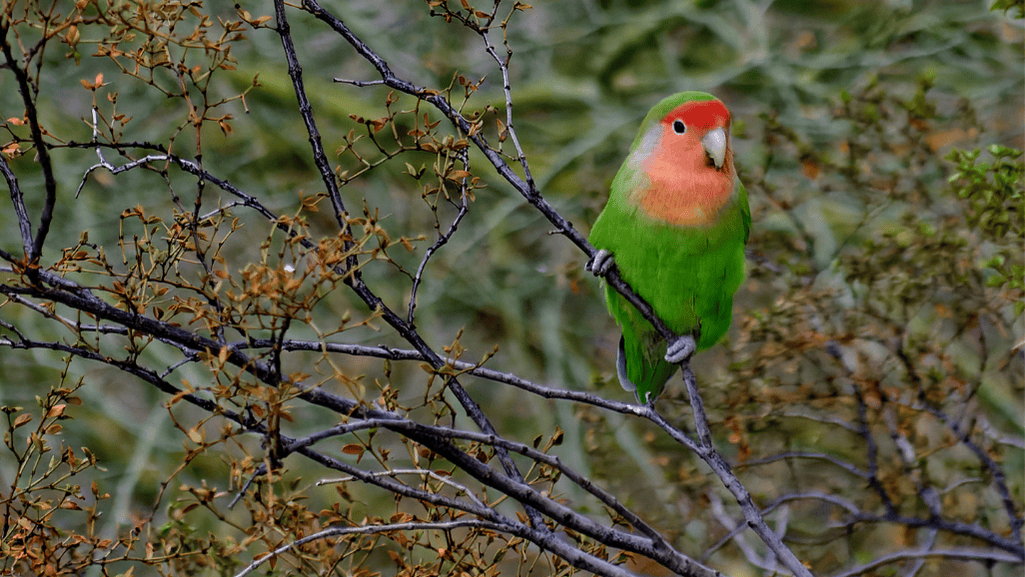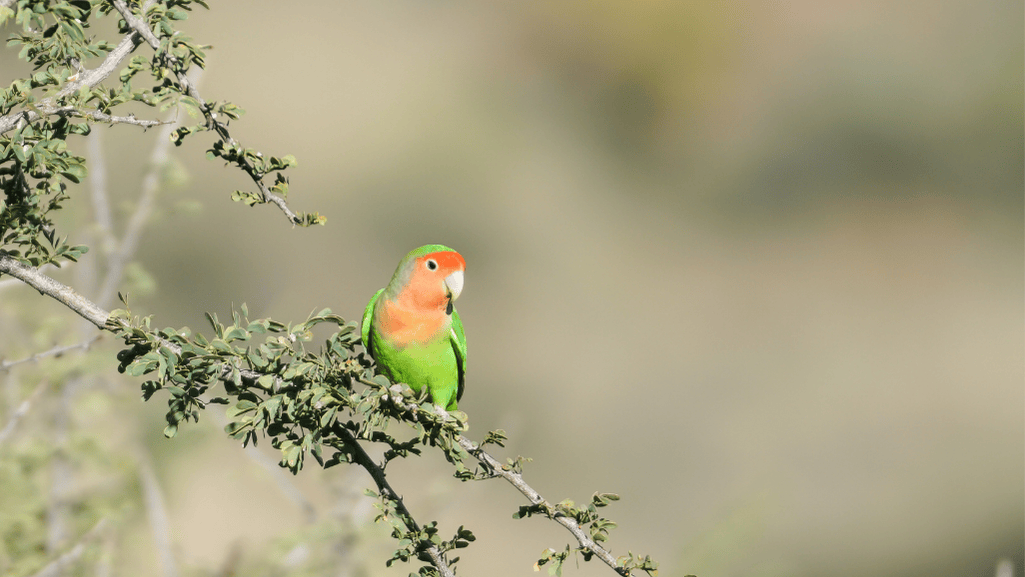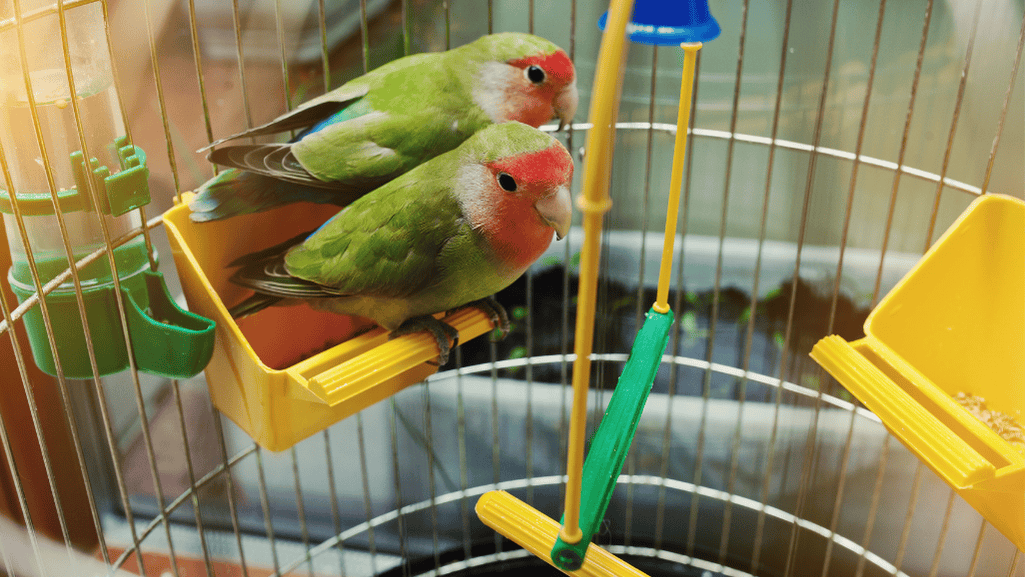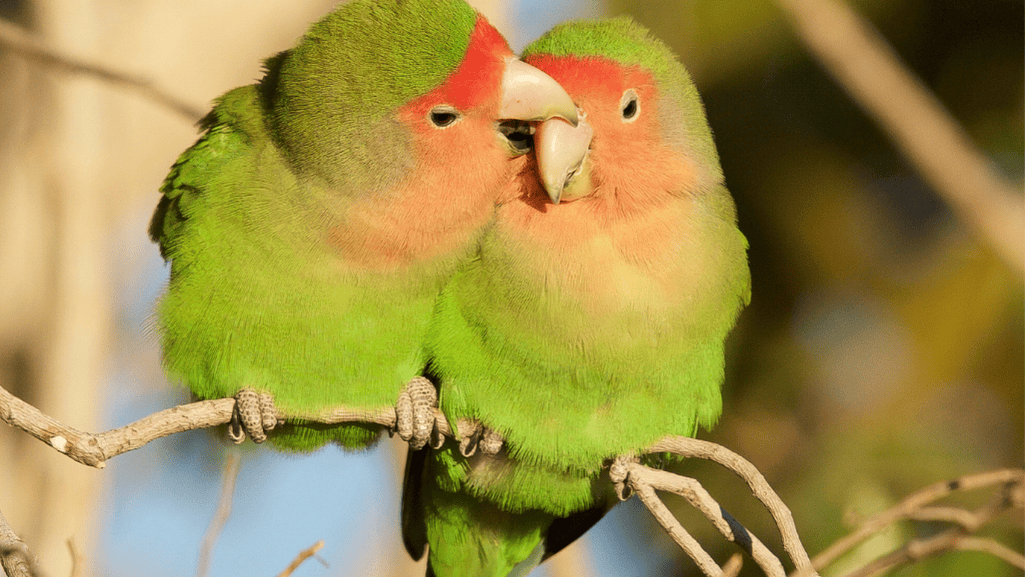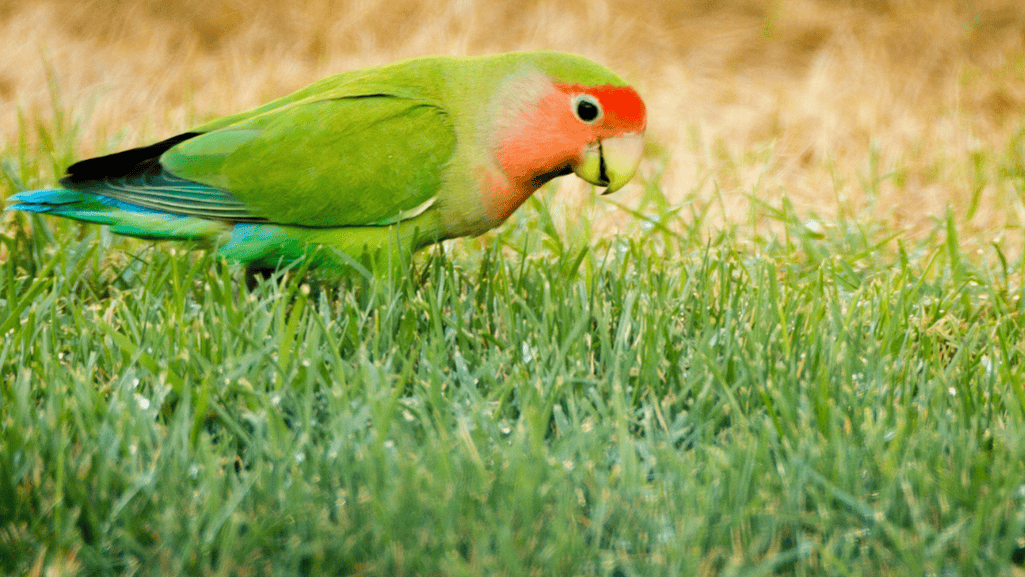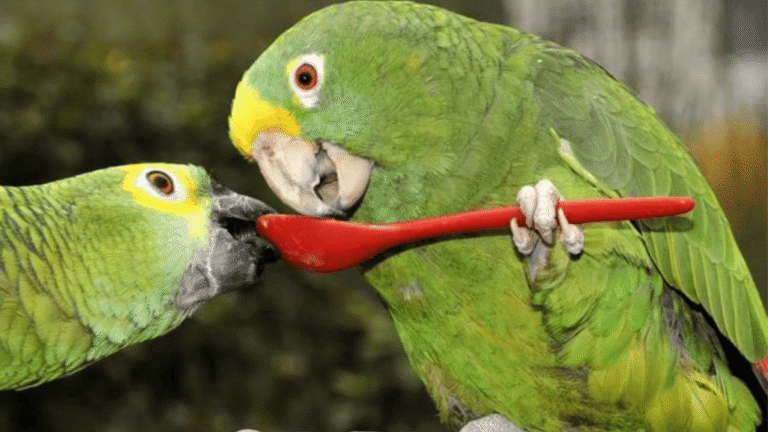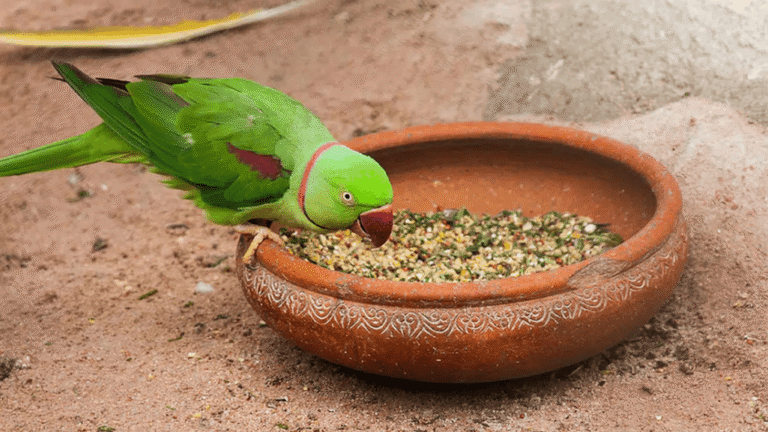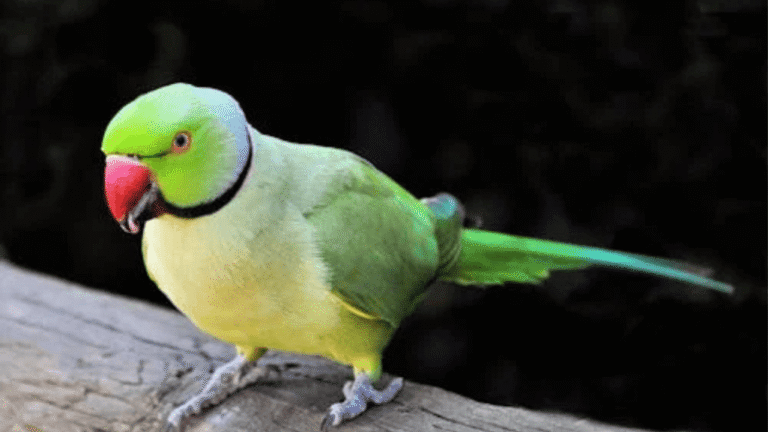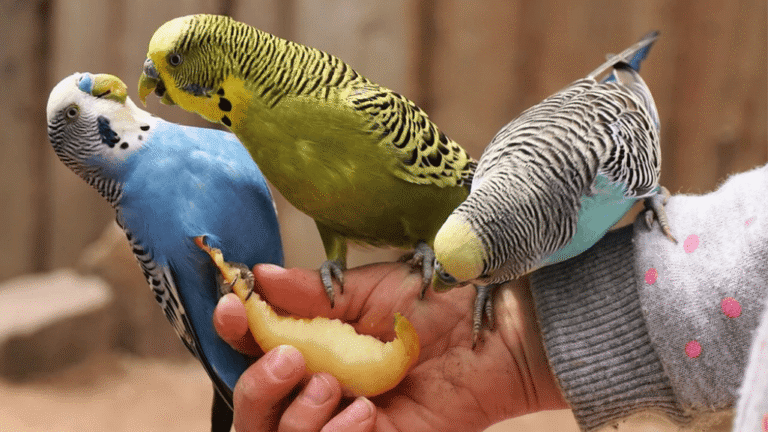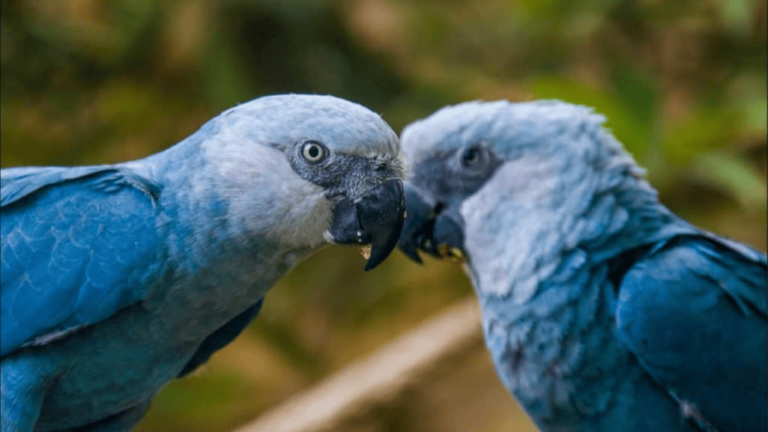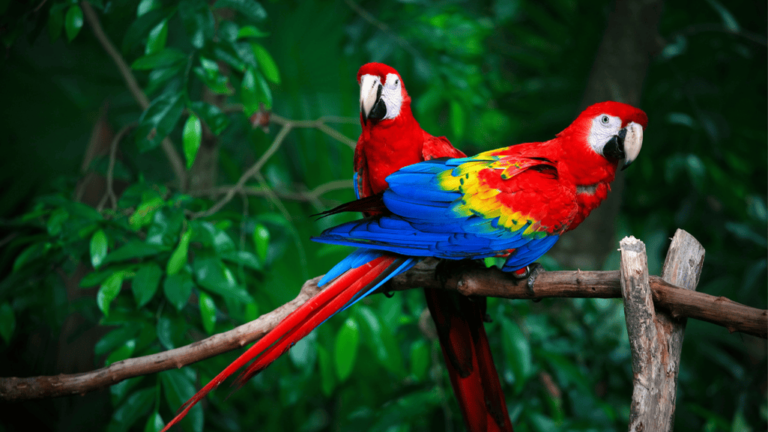The peach faced parakeet, also known as the rosy-faced lovebird or Agapornis roseicollis, is a vibrant bird. It has won the hearts of many bird lovers. These small parrots come from southwestern Africa, including Namibia, South Africa, and Botswana. They live in sparse woodlands and near deserts and mountains.
Peach faced parakeets are the biggest lovebirds, about 6 inches long and 55 grams heavy. They have a rosy-peach face and green body with blue tail feathers. In homes, they come in many colors thanks to breeding.
As pets, peach faced parakeets are very loyal and fun. They can live up to 20 years with the right care. It’s important to feed them well, give them a big cage with toys, and train them regularly.
Key Takeaways
- Peach faced parakeets are native to southwestern Africa and thrive in arid habitats.
- They are the largest of the lovebird species, measuring 6 inches in length and weighing 55 grams.
- These birds have a distinctive rosy-peach coloration on their face and upper breast.
- Peach faced parakeets can live up to 20 years in captivity with proper care.
- Providing a balanced diet, spacious cage, and regular socialization is crucial for their well-being.
Introduction to Peach Faced Parakeets
Peach faced parakeets, also known as rosy-faced lovebirds or Agapornis roseicollis, are charming and vibrant pet birds. They have captured the hearts of many bird lovers. These small parrot species are known for their affectionate nature and playful personalities. They are popular companions for bird lovers worldwide.
Appearance and Characteristics
Peach faced lovebirds are the largest among all lovebird species. They measure between 6 to 6.5 inches long and weigh around 50 to 70 grams. Their most distinctive feature is the rosy-peach coloration around their face and upper breast.
This contrasts beautifully with their mostly green body and bright blue tail feathers. The bill is horn-colored, the iris is brown, and the legs and feet are grey. Females tend to have a slightly duller overall appearance compared to males.
| Characteristic | Description |
|---|---|
| Length | 6 to 6.5 inches |
| Weight | 50 to 70 grams |
| Distinctive Feature | Rosy-peach coloration around face and upper breast |
| Body Color | Mostly green |
| Tail Color | Bright blue |
Native Habitat and Distribution
Peach faced lovebirds are native to the dry wooded areas of southwestern Africa. They range from Angola through Namibia. They are typically found in flocks of 8 to 20 birds.
But they may join larger flocks of several hundred that twist and turn in unison during flight. These resilient birds prefer arid habitats on the edges of deserts, sparse woodlands, and mountainous regions. They usually congregating around ripening fields of grains or water holes.
Their adaptability and charm have made them popular pet birds worldwide. Many dedicated owners provide them with proper avian care and attention.
Peach-faced lovebirds are typically found in flocks of 8 to 20 birds, but may join large flocks of several hundred that twist and turn in unison during flight.
Despite their popularity as pets, peach faced lovebirds are not considered threatened in the wild. The International Union for Conservation of Nature (IUCN) assesses their conservation status as “Least Concern.” However, it is essential for potential owners to research responsible breeders.
Ensure that their new feathered friend comes from a reputable source. This source should prioritize the health and well-being of these captivating conures.
Choosing a Peach Faced Parakeet as a Pet
Thinking about getting a Peach Faced Parakeet as a pet? It’s key to know their unique personality and how they fit into your family. These birds are lively and loving, making them great pets for many. But, you must check their temperament, how they get along with other pets, and if they’re right for your home.
Personality and Temperament
Peach Faced Parakeets, or lovebirds, are very social and full of energy. They love to be around people and need lots of attention to stay happy. These birds are smart and can bond strongly with their owners, showing love and affection.
But, they can also be territorial and possessive, especially when breeding or feeling threatened. They might get aggressive with other birds or people if not socialized right. Early, gentle training and positive reinforcement can help them be loving pets.
Compatibility with Other Birds and Pets
Peach Faced Parakeets can live with other birds if they’re the same size and friendly. But, they can be bold and try to boss around bigger birds. Make sure they have enough space, food stations, and perches to avoid fights.
With other pets like cats and dogs, be careful. Lovebirds are small and might be seen as prey. Always watch when they’re with other pets to keep them safe.
Suitability for Different Living Situations
Think about your lifestyle and home before getting a Peach Faced Parakeet. They need a big cage or aviary to fly and play, and lots of toys and social time. If you live in a small place, a lovebird might not be the best fit.
Also, these birds can be loud, with their sounds filling the air all day. If you live near others or don’t like noise, this could be a problem. But, if you have a bird room or a home that can handle their sounds, a lovebird can add joy to your life.
Choosing a Peach Faced Parakeet as a pet should be a careful decision. You need to understand their needs, provide the right environment, and commit to caring for them for a long time.
Housing and Cage Requirements
Creating a good home for your peach faced parakeet is key to their health. When picking a cage, think about size, design, and safety. A big, well-set-up cage lets your parakeet explore, play, and act naturally.
Appropriate Cage Size and Design
Choosing the right cage size is important for your peach faced parakeet. A cage of 45.7cm x 45.7cm x 45.7cm (18 x 18 x 18 inches) is the minimum for one lovebird. But, bigger cages are better, giving more room for your bird to move and play.
For a cage, go for a rectangular or square shape with horizontal bars. Lovebirds love to climb and move, so horizontal bars are best. Avoid round cages to prevent your bird’s feet from getting stuck.
Stainless steel cages are durable and easy to clean, but they cost more than powder-coated ones. Make sure the bar spacing is right, between 1.27cm and 1.58cm, to keep your bird safe.
| Cage Requirement | Recommendation |
|---|---|
| Minimum Dimensions (Single Lovebird) | 45.7cm x 45.7cm x 45.7cm (18″ x 18″ x 18″) |
| Space per Additional Lovebird | 1m3 (35 cubic feet) |
| Bar Spacing | 1.27cm – 1.58cm (0.5″ – 0.62″) |
| Cage Shape | Rectangular or Square with Horizontal Bars |
| Cage Material | Stainless Steel (Durable and Easy to Clean) |
Perches, Toys, and Enrichment
Adding perches, toys, and enrichment items makes your peach faced parakeet’s cage fun. Use natural wood perches to keep your bird’s feet healthy. Replace plastic perches with fresh branches from safe trees like apple, pear, or willow.
Give your lovebird toys that encourage chewing, climbing, and problem-solving. Change toys often to keep your bird interested and mentally sharp. Toys that mimic foraging, like puzzle feeders, are great for your parakeet’s natural instincts.
Cleaning and Maintenance
Keeping your peach faced parakeet’s cage clean is vital for their health. Clean the cage daily to remove waste and debris. Wash food and water dishes every day. Clean the cage, perches, and toys with a bird-safe disinfectant weekly. Replace any damaged items right away.
Proper locks that lovebirds cannot unlock should be prioritized to prevent escapes. Drawbridge or swinging door mechanisms are preferable over guillotine style for lovebird cages to prevent accidental escapes.
By giving your peach faced parakeet a big, well-designed cage with lots of enrichment and keeping it clean, you’ll make sure they’re happy and healthy. A good home that meets their natural needs will make them very happy.
Peach Faced Parakeet Diet and Nutrition
Proper parrot nutrition is key for peach faced parakeets, also known as lovebirds. As exotic birds, they need a diet that’s balanced and meets their needs. A good diet helps keep their colors bright and supports their health, including beak and feather grooming.
The base of a peach faced parakeet’s diet should be a high-quality pellet or seed mix made for lovebirds. Pellets give them the nutrients they need, while seeds add variety. Lovebirds might be picky, so be patient and keep trying new foods.
Fresh fruits and veggies should also be a big part of their diet. Apples, peaches, mangoes, grapes, and papayas are great, but give them in small amounts because of their sugar. Bell peppers, broccoli, spinach, and kale are good for them and can be eaten raw or lightly cooked. Watch how your bird reacts to new foods and adjust as needed.
Almonds are considered the healthiest nut for lovebirds, as they are rich in calcium, dietary fiber, and protein, containing 14 grams of fat per ounce.
Nuts and seeds can be treats or part of foraging games. Almonds, cashews, and pistachios are good, but only give them a little because they’re high in fat. Chia seeds, flax seeds, millet, oats, and quinoa are also good, but don’t replace their main diet. Choose unsalted and raw nuts and seeds to avoid too much salt and toxins.
| Food Category | Recommended Amount | Examples |
|---|---|---|
| Pellets | 75-80% of diet | High-quality lovebird pellets |
| Fruits and Vegetables | 20-25% of diet | Apples, peaches, bell peppers, broccoli |
| Nuts and Seeds | Treats or foraging | Almonds, chia seeds, millet |
| Flowers | Occasional treat | Pesticide-free hibiscus, chrysanthemum |
Flowers can be treats, adding color and nutrition. Bougainvillea, hibiscus, and chrysanthemum are safe, but make sure they’re free of pesticides.
Good parakeet care means watching how much they eat, keeping water fresh, and cleaning their food area. Lovebirds don’t need grit or gravel, as they eat seeds without the hull. A varied diet helps keep your peach faced parakeet healthy and encourages natural behaviors like foraging and parakeet training.
Training and Socialization
Training and socializing your pet bird, like a peach faced lovebird, is crucial. These small parakeets are smart and love to interact. Without enough socialization, up to 76% may become aggressive towards strangers.
Creating a strong bond with your lovebird is key to successful training. Young birds raised by hand are better pets because they bond well with humans. Adult birds from aviaries can be harder to tame. Spend daily time with your bird, giving treats and gentle handling to build trust. Positive reinforcement can make your parrot more friendly to new people by 65%.
Taming and Bonding with Your Lovebird
Taming your peach faced lovebird takes patience and effort. Let your bird get used to its new home before handling it. Once it’s comfortable, start giving treats through the cage bars. Then, offer treats from your hand inside the cage.
As your bird gets more comfortable, teach it to step up onto your finger or a perch. In fact, 80% of parrots improve their social skills by learning to step up for new people.
Teaching Basic Tricks and Commands
Lovebirds, like many avian pets, can learn tricks and commands with positive training. Start with simple tricks like waving or nodding, using treats as rewards. Clicker training works well for more complex behaviors.
Keep training sessions short and fun for your bird. With proper training, peach faced lovebirds can learn many entertaining tricks, strengthening your bond.
Addressing Common Behavioral Issues
Peach faced lovebirds can have behavioral problems if their needs aren’t met. Issues like aggression, fearfulness, and too much talking can arise. To prevent or fix these, make sure your bird gets enough socialization, mental stimulation, and exercise.
Provide a varied diet, change toys often, and offer lots of interaction and playtime outside the cage. If problems continue, seek help from an avian vet or behaviorist.
| Socialization Technique | Success Rate |
|---|---|
| Structured 12-step socialization plan | 70% |
| Grab training with multiple individuals | 85% |
| Private outings for parrots | 60% |
Consistent training, socialization, and care are key to a well-behaved pet bird. By dedicating time and effort to your lovebird’s training and socialization, they will be a cherished companion for many years.
Health and Wellness
Keeping your peach faced parakeet healthy is key to their long life and happiness. As a caring owner, knowing about common health issues and how to prevent them is vital. This ensures your bird stays in great shape.
Common Health Problems in Peach Faced Parakeets
Peach faced parakeets face many health challenges. Some common issues include:
- Respiratory infections, such as chlamydiosis
- Nutritional deficiencies, especially when fed an inadequate diet heavy in seeds
- Bacterial and fungal infections
- Feather plucking and self-mutilation
- Egg-binding in female birds
Signs of Illness and When to Seek Veterinary Care
It’s crucial to watch for illness signs in your parakeet. Look out for:
- Lethargy and decreased activity levels
- Loss of appetite or changes in eating habits
- Ruffled or unkempt feathers
- Discharge from the eyes, nose, or beak
- Abnormal droppings or changes in bowel movements
- Difficulty breathing or wheezing
- Swelling or lumps on the body
If you see these symptoms, see an avian vet quickly. Early action can stop small problems from getting worse.
Preventive Care and Regular Check-ups
To keep your parakeet healthy, offer a balanced diet and a clean, big home. Regular vet visits are also crucial. Preventive care includes:
| Preventive Measure | Description |
|---|---|
| Annual check-ups | Schedule yearly visits with an avian vet for physical exams and health screenings |
| Balanced diet | Provide a varied diet consisting of high-quality pellets, fresh fruits and vegetables, and limited seeds |
| Clean environment | Maintain a clean cage with regular disinfection and replace perches and toys as needed |
| Stress reduction | Minimize stress by providing a calm, consistent environment and plenty of mental stimulation |
| Beak and nail trimming | Have your parakeet’s beak and nails trimmed by a professional as needed to prevent overgrowth |
By knowing about parakeet health, spotting illness signs, and caring properly, you can help your peach faced parakeet live a long, happy life. They will be a beloved part of your family.
Breeding Peach Faced Parakeets
Breeding peach-faced lovebirds is a rewarding hobby for both new and seasoned bird breeders. These birds, related to monk parakeets and quaker parrots, are loved for their bright colors and loving nature. Before starting, it’s key to know their special needs and the effort needed to raise healthy chicks.
Preparing for Breeding
For successful breeding, peach-faced lovebirds need a good home. English budgie nesting boxes are great for lovebird breeding. They have a special design that helps with egg hatching, especially in dry places like Southern California. You might need to use special lights indoors to mimic the sun.
It’s smart to keep breeding pairs’ cages apart to avoid visual stress but allow them to hear each other. A diet rich in whole foods, like wheatgrass and Roudybush pellets, is crucial for their health. Also, avoid loose perches in breeding cages to prevent fertility issues.
Incubation and Hatching
Peach-faced lovebirds usually lay 4 to 5 eggs at a time. The eggs hatch after 23 to 28 days. Eggs might not hatch due to many reasons, like poor nutrition or infections. Keeping breeding pairs healthy and well-fed is key to successful hatching.
| Incubation Period | Average Clutch Size | Fledging Age |
|---|---|---|
| 23-28 days | 4-5 eggs | Around 43 days |
Hand-raising Baby Lovebirds
Some breeders choose to raise baby lovebirds by hand to bond with them. This requires a lot of time and effort, as young birds need to eat often. Special formulas for cockatiels and other small parrots can help with their nutrition.
Testing the DNA of young lovebirds can tell you their gender, costing between $15 and $22. Avian vets can also do this test, but it might be expensive for many birds.
Breeding peach-faced lovebirds can be a joyful and enriching experience, but it is essential to approach it with knowledge, preparation, and a commitment to the well-being of these captivating psittacine companions.
Peach Faced Parakeet Color Mutations
Peach Faced Parakeets, also known as lovebirds, are loved by many. They have beautiful colors and fun personalities. These birds can live up to 15 years with good care, making great friends for a long time.
It’s hard to tell if a Peach Faced Lovebird is a male or female without knowing their parents. They have two main colors: Green and Blue. The Blue Series has three types: Dutch Blue, White-Faced Blue, and Sea Green.
The Peach Faced Parakeet world is full of interesting colors. Some notable ones are:
- Simple Recessive Mutations: Blue, Whitefaced Blue, and Seagreen
- Sex-Linked Recessive Mutations: Lutino, American Cinnamon, Australian Cinnamon
- Partial Dominant and Co-Dominant Mutations: Dark Factor (Jade, Olive, Cobalt, Slate), Violet
- Dominant Mutations: American Pied, Green
Lovebirds can’t be split to Violet, Green, or American Pied because these are dominant. Some colors, like red suffusion, might mean the bird is sick.
The Peach-faced Lovebird is one of the most common psittacine species in aviculture, alongside Budgerigars and Cockatiels. This species has produced a variety of mutations and combinations in a relatively short period, potentially even more than the Budgerigar.
To breed Peach Faced Parakeets, knowing how colors are passed down is key. There are three ways: recessive, sex-linked, and dominant. For example, a Green Normal and a Blue can have Normal Green kids that can also be Blue. Breeders should avoid too much inbreeding to keep the birds healthy and big.
| Mutation Type | Examples | Inheritance Pattern |
|---|---|---|
| Autosomal Dominant | Dark Factor, Violet, Pied | Requires only one chromosome of the pair for visibility |
| Autosomal Recessive | Turquoise, Aqua, Orange-faced, Marbled | Requires both chromosomes for visibility |
| Sex-Linked Recessive | Lutino, Cinnamon | Influences males and females differently due to sex chromosomes |
Peach Faced Parakeets are not just beautiful; they’re also great friends. They need training, social time, and fun toys to stay happy and healthy. With their bright colors and lively nature, they are a joy to have around.
Interesting Facts About Peach Faced Parakeets
Peach faced parakeets, also known as lovebirds, are fascinating creatures. They have unique behaviors and characteristics. These small, vibrant birds have captured the hearts of bird enthusiasts worldwide. They are cherished pets and subjects of scientific interest.
Unique Behaviors and Habits
One of the most distinctive behaviors of peach faced lovebirds is their nesting ritual. Only female peach faced lovebirds chew paper into strips and tuck them into their back feathers. This shows their ingenuity and adaptability.
Peach faced parakeets are highly social. In the wild, they live in small flocks, engaging in lively interactions and foraging together. When food is plentiful, these flocks can grow to hundreds of individuals, creating a spectacular sight. Softschools.com provides more information on their social behavior.
Popularity and Prevalence in Captivity
The charming appearance and endearing personalities of peach faced parakeets have made them incredibly popular as pets. Their compact size, vibrant coloration, and affectionate nature have won the hearts of bird lovers worldwide. In captivity, these birds can live up to 20 years, forming strong bonds with their human companions.
A feral flock of peach faced lovebirds has established itself in Phoenix, Arizona. This flock has adapted remarkably well to the urban environment, showcasing their resilience and adaptability.
| Characteristic | Details |
|---|---|
| Length at maturity | 5 to 7 inches |
| Lifespan in captivity | Up to 20 years |
| Number of subspecies | 9, including the peach faced lovebird |
| Exercise requirements | Several hours outside the cage daily |
Conservation Status in the Wild
While peach faced lovebirds are cherished companions in captivity, their conservation status in the wild is important. The International Union for Conservation of Nature (IUCN) lists them as a species of least concern. This indicates that their wild populations are not currently facing significant threats.
However, the global population of peach faced lovebirds is unknown. It is believed to have experienced a decline due to their popularity among collectors. In certain areas, their numbers may have increased due to human interventions, such as the creation of new water sources and the construction of artificial structures that provide additional nesting sites.
Despite their stable conservation status, it is essential to promote responsible ownership and support conservation efforts. This ensures the long-term well-being of peach faced parakeets in both captivity and the wild.
Costs and Considerations of Keeping a Peach Faced Parakeet
Thinking about getting a peach faced parakeet? It’s key to know the costs upfront. These birds can be great pets, but they need care that comes with a price tag. This ensures they stay healthy and happy.
Initial Purchase Price and Ongoing Expenses
The price of a peach faced parakeet varies. It depends on the bird’s age, color, and where you buy it. Prices range from $25 for a basic green lovebird to over $200 for a rare one from a good breeder. Besides the initial cost, there are ongoing expenses like:
- Cage and accessories (perches, toys, food and water dishes)
- High-quality pellet diet and fresh fruits and vegetables
- Regular veterinary check-ups and potential medical expenses
- Grooming supplies (nail clippers, bird-safe shampoo)
- Enrichment items to prevent boredom and promote mental stimulation
Even though peach faced parakeets are small, they need a big cage. A single bird needs a cage at least 18 inches square. A pair needs a cage about 24 inches square. Smaller cages mean more time outside the cage for exercise.
Time Commitment and Lifestyle Adjustments
There’s more to owning a peach faced parakeet than money. You also need to think about the time and lifestyle changes. These birds love to interact with people. They need daily playtime and training to stay happy and healthy.
With proper care, peach faced parakeets can live up to 15 years. So, it’s important to be ready for a long-term commitment. This might mean changing your daily routine, like:
- Setting aside dedicated time for interaction and playtime with your lovebird
- Ensuring your home is bird-safe and free from potential hazards
- Arranging for proper care during vacations or extended absences
- Maintaining a consistent cleaning and feeding schedule
| Expense Category | Estimated Cost |
|---|---|
| Initial Purchase Price | $25 – $200+ |
| Cage and Accessories | $100 – $300 |
| Annual Food and Supplies | $150 – $300 |
| Annual Veterinary Check-ups | $50 – $150 |
Thinking about the cost, expenses, and time needed for a peach faced parakeet? It helps to decide if they’re right for you. This way, you can make a smart choice for your lifestyle and budget.
Frequently Asked Questions About Peach Faced Parakeets
If you’re thinking about getting a peach faced parakeet or already have one, you might have questions. We’ll cover some common lovebird care topics. This will help you feel more confident and informed about your parakeet.
Many owners worry about their bird’s reproductive health. Female lovebirds can lay eggs without a mate. This can lead to aggression and health risks, especially in young birds. It’s important to prevent this by changing their environment.
Another big question is how long peach faced lovebirds live. With the right care, they can live up to 20 years. Diet, housing, and vet visits are key to their long life.
People also wonder about the cost of getting a peach faced parakeet. Prices vary based on color. Normal green ones start at $25, while rarer ones can cost $200 or more.
Some owners hope their parakeet will talk. But, only about one in a thousand lovebirds can talk.
Health is a big concern for parakeet owners. Lovebirds can get sick with chlamydiosis, self-mutilate, and have diet problems. A balanced diet is crucial to avoid these issues.
| Concern | Information |
|---|---|
| Lifespan | Up to 20 years, with an average of 12-15 years or more |
| Price Range | $25 for normal green to $200+ for rarer mutations |
| Talking Ability | Slim, approximately 1 in 1,000 lovebirds |
Knowing about these common questions and concerns will help you prepare for owning a peach faced parakeet. Being well-informed is key to a happy, healthy lovebird.
Conclusion
Peach faced parakeets, or lovebirds, are wonderful pets for bird lovers. They have bright colors, a loving nature, and are fun to watch. As an ideal parakeet companion, they bond strongly with their owners and love to be around people.
Before getting a peach faced parakeet, you need to know their needs. They need a big cage, a healthy diet, and lots of toys and playtime. These birds live for about 15 years, so owning one is a big commitment.
Following good care tips is important for your parakeet’s health and happiness. This includes regular vet visits, training, and socializing. Peach faced parakeets are great pets for anyone, whether you’re new to birds or have experience.
Starting your journey with a peach faced parakeet requires patience, love, and understanding. With the right care, your lovebird will be a loving friend for many years. They will bring joy, laughter, and unforgettable moments into your life.


